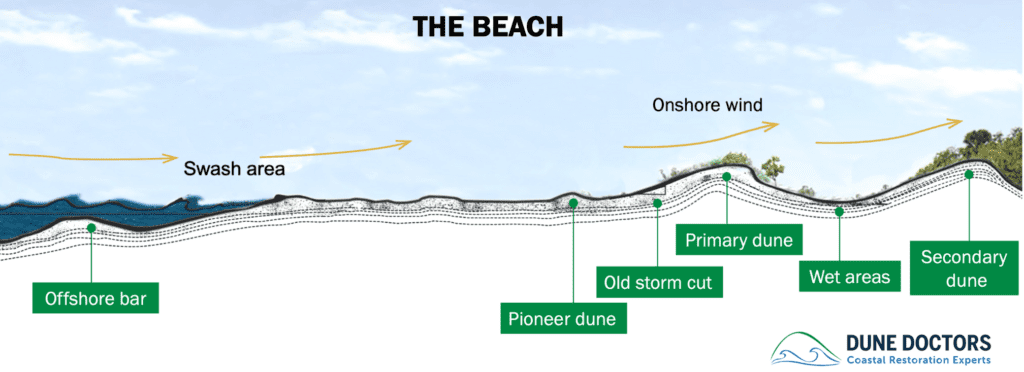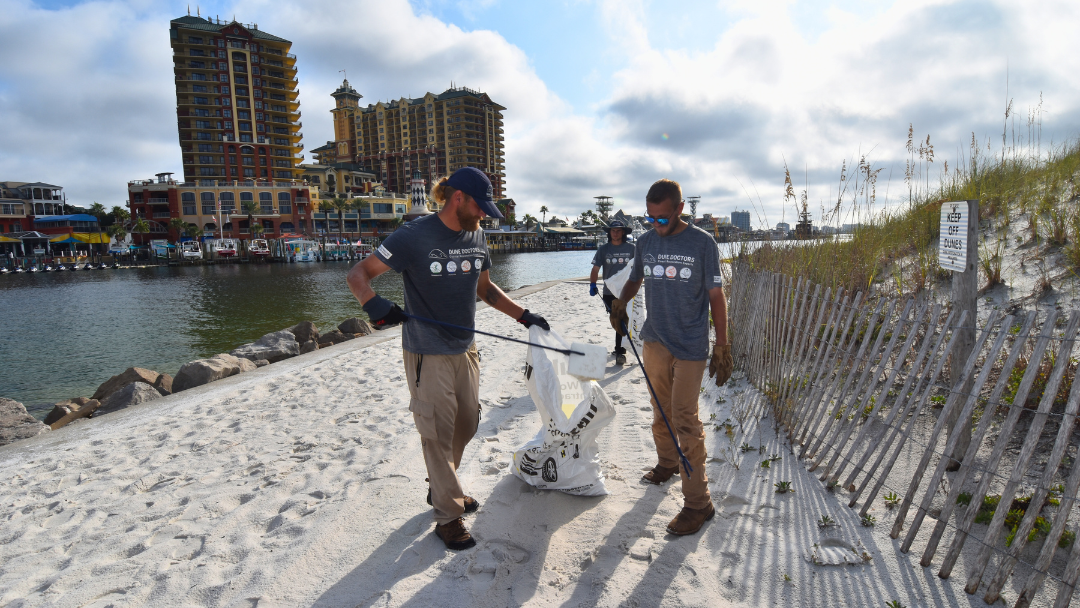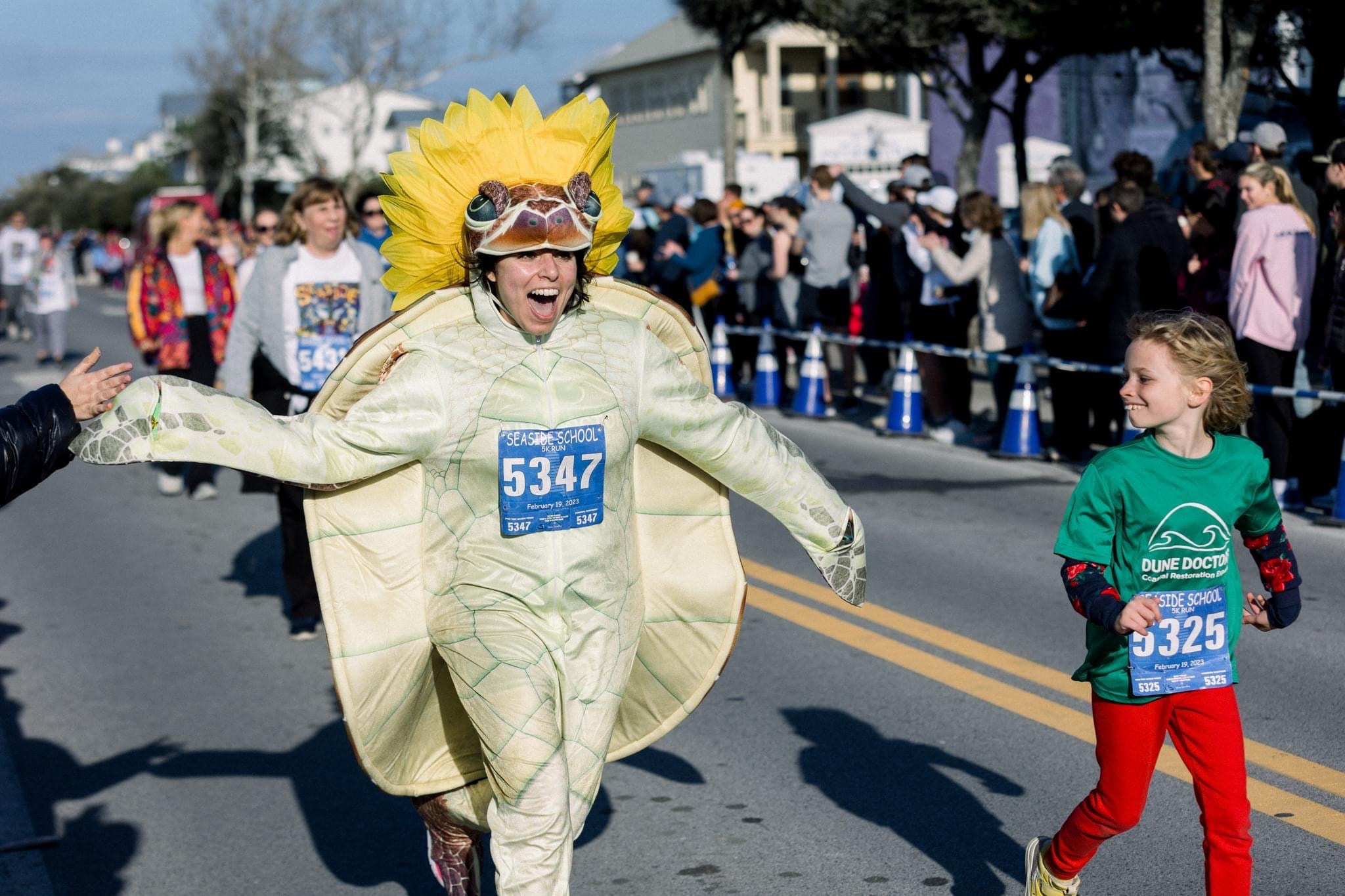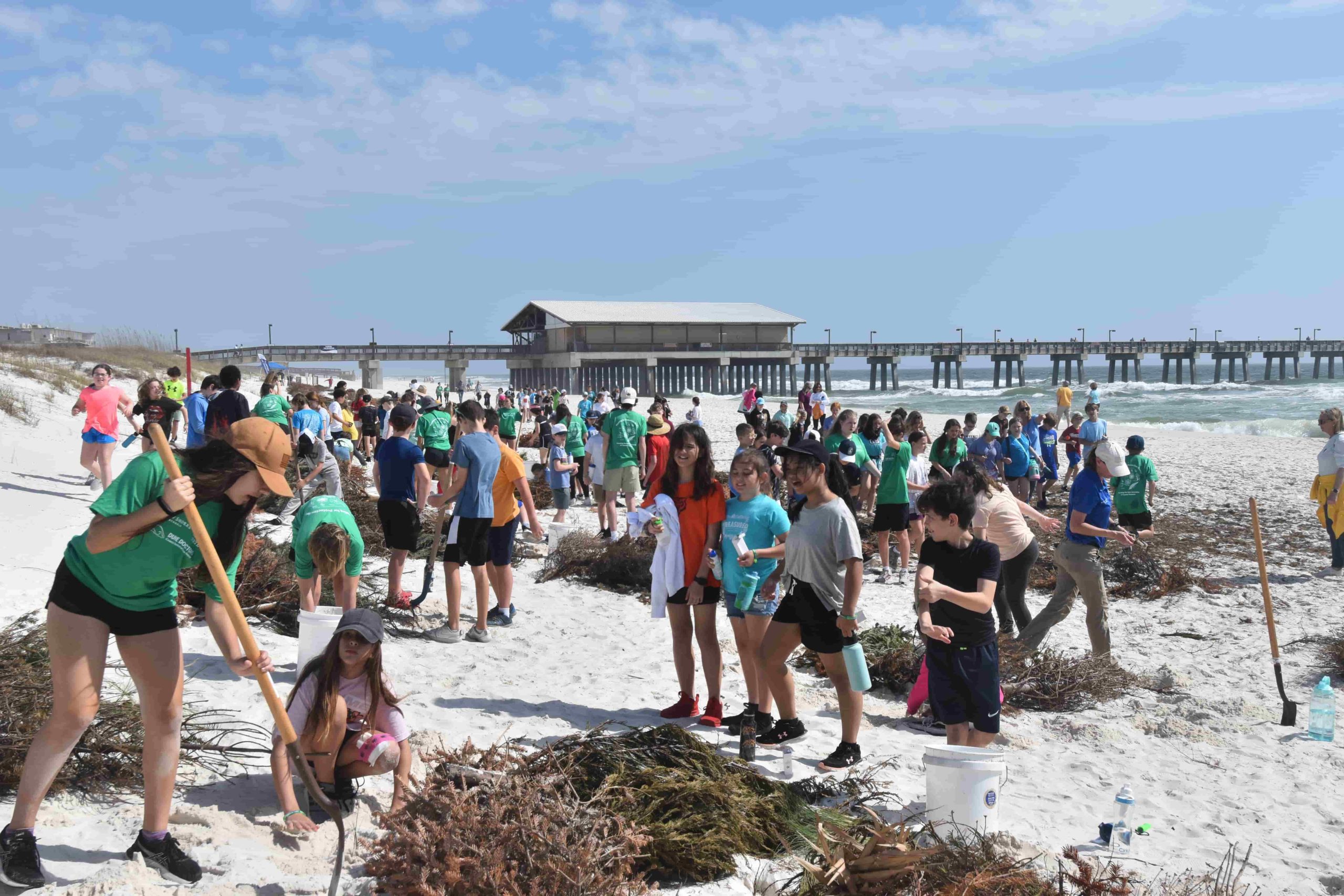An introduction to the different forces that shape your protective coastal landscape.
Article Highlight: Wind, water, and vegetation are the three primary forces that contribute to the formation and erosion of coastal dunes.
Key Takeaway: While the contour of the coastline changes daily, proactive waterfront homeowners can work with Dune Doctors to implement an environment-specific plan that aligns with coastal cycles and encourages sand to accumulate on their property.
Application: Call 866-386-3737 today to request a Dune Health Assessment of your coastal property. Have our team repair erosion-prone areas on your existing dune and determine the optimal location to initiate another natural barrier.
How do Coastal Dunes Form?

In short, coastal dunes are vegetated sand mounds that form along beaches where sand is available. As different coastal forces carry sand onto and along the beach, particles collide with obstacles, like sand fences and native grasses, and drop, accumulating where they fall and initiating a dune. If undisturbed, native vegetation will hold the sand in place, and the dune will slowly increase in size. Over time, multiple rows of dunes will form, between the beach and the woody scrub zone. Wind and water action continuously reshape the coastal environment, so dunes tend to grow, shrink, and move following prevailing winds.
Why Should Coastal Communities Care about their Dunes?
Communities that have introduced permanent structures into this dynamic ecosystem benefit greatly from working with Coastal Restoration Experts to limit dune movement. Dunes are nature’s first line of defense against the destructive impacts of storm surge. To achieve sustainable resiliency, Dune Doctors encourages coastal homeowners to view their dune system as a valuable asset that must be invested in, respected, and cared for. Through the strategic restoration and maintenance of this protective landscape, Dune Doctors helps waterfront property owners strengthen their existing dune(s), add environment-specific sand to correct erosion, and initiate new, continuous berms (a continuous protective barrier even in height and sand distribution) that encourage sand accretion (sand build-up) across the width of their property.
What Physical Forces Build and Erode the Coastline?
Two physical forces push sand along the beach: winds and tides. The wind moves sand in two ways by blowing it along the beach and by forming waves. The wind speed, the duration of the wind, and the fetch (how wide the body of wind is) all determine how much sand the wind will move and the size and strength of the waves it will form. Waves crash onto the beach and deposit or erode sand from the swash zone (the area where waves run up and down the beach). A wave deposits sand on the beach if it loses most of its energy while pushing landward. The daily variance in the tide level also plays a critical role by exposing different beach sections to wind and wave action. The tide can also transport sediment. Whether or not these forces will take (erode) or deposit sand (accrete) is determined by a combination of environmental factors, including geological predisposition to erosion or accretion, the width and slope of the beach, moisture, vegetation present, weather, and sand availability.
How Does Wind Transport Sediment to Build Coastal Dunes?
The process by which wind pushes sand is called aeolian transportation, and it occurs in three forms: suspension, saltation, and creep. Suspension is when sand is picked up and carried in the wind. Saltation is when the sand particles bounce along the beach, while creep is when sand particles collide and push each other. Coastal homeowners can take advantage of aeolian transportation by working with Dune Doctors to strategically introduce obstacles (sand fencing and vegetation) along their beach to build up and stabilize sand on their property.
How Does Wave Action Help Build Sand Dunes?
The impact of waves starts offshore in the surf zone, where waves crest and break due to friction between wind and the surface of the water and the decrease in depth, as the water approaches the beach. This breaking motion creates turbulence that generates currents and swirls sand upward. The currents can flow parallel (called a longshore current), perpendicular, or cross-shore called undertows and rip currents. These currents then push the sand while some waves, called the swash, surge up through the swash zone between high and low watermarks on the beach. When the swash has greater forwarding momentum than retreating energy, some of the water sinks into the beach and deposits wave-borne particles in place. During a single storm, sand particles can move from the beach to sand bars way offshore in minutes or be pushed a couple of miles down the beach in a matter of hours.
How Does the Tide Help Build Sand Dunes?
Tides play two roles in sand movement it can transport sediment and distribute wave energy by changing the depth of the water and the position of the shoreline. The moon’s gravitational pull and earth’s rotational force determine the tide’s height. Depending on whether there is a high or low tide, the beach will be narrower or broader, exposing different beach areas to the processes discussed above. The daily changes in the tide level are why the coast’s contour may look completely different from morning to night.
How do Coastal Plants Encourage the Formation of Dunes?
Pioneer grasses like Sea Oats and Panic Grass grow towards the sea and are the first to stabilize a habitat after a destructive storm. These plants have complex root systems that weave through the sand, creating massive webs that anchor dunes in place. In addition to the grasses, other plants also play vital ecological roles in sustaining robust dunes. Ground covers help retain sand while flowers improve the environment’s aesthetics and provide food and protection for beach wildlife. Orencio Duran and Hans J. Hermann developed a set of equations that analyzed the ratio between the “dune erosion rate and vegetation growth velocity (4).” In 2013, Duran extended his modeling to include ecological and physical effects observing fundamental interactions between wind flow, sand transport, topography, the shoreline, and vegetation. His research argued that “plant zonation (plant zonation is the distribution or arrangement of plants in a habitat determined by environmental factors), rather than sediment supply, controls coastal vulnerability to storms by determining maximum dune size (4).” Through his research, Duran observes that without vegetation coastal dunes will only reach a limited height before dissipating. In other words, Duran recognizes that dunes are critical barriers that protect waterfront communities from destructive waves and suggests that dune-building vegetation plays a critical role in determining the size and resiliency of coastal dunes.
How to Align Restoration Efforts with Coastal Forces
The best way to build sustainable coastal resiliency is to strategize restoration efforts that take physical (wind and waves) cycles and ecological (vegetation) processes into account. Different solutions include beach renourishment, dune construction, sand fencing, and coastal vegetation. Communities with eroding shorelines may invest in beach renourishment and artificially add sand to widen their beach. A greater beach area heightens protection against storm surge and increases sediment availability for dune growth. Property owners with no protective dune can work with Dune Doctors to artificially construct a dune by placing and sculpting sand berms and then stabilizing the loose sand with vegetation. Alternatively, or in conjunction to beach renourishment, communities can install sand fences paired with dune-building plants to limit sand movement and initiate a protective berm in a location most advantageous to them. Finally, investing in high-quality plants is critical to sustaining protection against storm surge. Dune Doctors has a dune maintenance program that provides season-specific care based on the yearly cycle of dune-building grasses. Reach out to Dune Doctors today to schedule a Dune Health Assessment and have our coastal restoration team evaluate the potential failure points of your dune system and develop personalized solutions that reflect the unique environmental condition of your property.
References and Additional Resources:
1. “Beach and Shoreface Nourishment.” Climate Adapt, OURCOAST II Project, https://climate-adapt.eea.europa.eu/.
2. “Coastal Effects of Tides.” U.S. Army Engineer Institute for Water Resources (IWR), https://www.iwr.usace.army.mil/Missions/Coasts/Tales-of-the-Coast/Coastal-Dynamics/Tides/.
3. Davis, Richard Albert. “Depositional Systems: An Introduction to Sedimentology and Stratigraphy.” Google Books, Prentice Hall, https://books.google.com/books/about/Depositional_systems.html?id=x08SAQAAIAAJ.
4. Durán, Orencio, and Laura J. Moore. “Vegetation Controls on the Maximum Size of Coastal Dunes.” PNAS, National Academy of Sciences, 22 Oct. 2013, https://www.pnas.org/content/110/43/17217.
5. US Department of Commerce, National Oceanic and Atmospheric Administration. “Why Does the Ocean Have Waves?” NOAA’s National Ocean Service, 1 June 2013, https://oceanservice.noaa.gov/facts/wavesinocean.html.
6. “Voyager: Why Does Sand Move and How Does It Get from Place to Place?” Scripps Institution of Oceanography, 1 May 2008, https://scripps.ucsd.edu/news/voyager-why-does-sand-move-and-how-does-it-get-place-place.






